Last-Minute NYC Holiday Gift Guide 🎁
We’ve created a holiday gift guide with presents for the intrepid New Yorker that should arrive just in time—


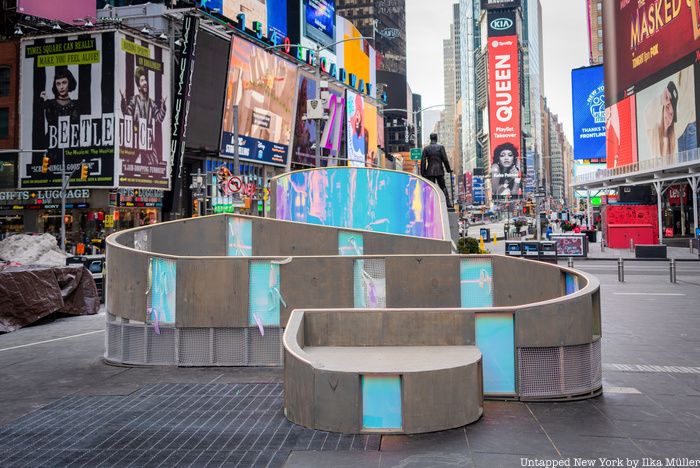
We might be in the midst of a huge snowstorm, but February is always a great month for new public art. Once you can dig yourself out, check out everything from the annual Times Square Heart unveiling to more timely works that are a commentary on COVID-19 and social justice, plus art exhibitions in surprising locations. Outdoor art installations are even more critical in the pandemic, with some shuttered businesses taking advantage of their exterior facades to communicate artistically with the public. Here are the new public art installations to see this month in New York City!
On February 10th, the 2021 Times Square Design Competition: Love in Our Times winner will be unveiled. This year’s winner is called Love Letters, designed by Soft-Firm (from Lexi Tsien and Talitha Liu), curated by Reddymade and developed in consultation with worthless studios. Visitors can leave love letters inside the sculpture, which forms two hearts when viewed from above. The sculpture’s material is intended to be a reference to New York City’s building facades, “using plywood as a material of public engagement to mimic a scrolling storefront.” The plywood is alternated with mirrored windows that will reflect the public space around it. The sculpture will also provide seating a multiple levels. Love Letters will be on view from February 10th to March 10th.
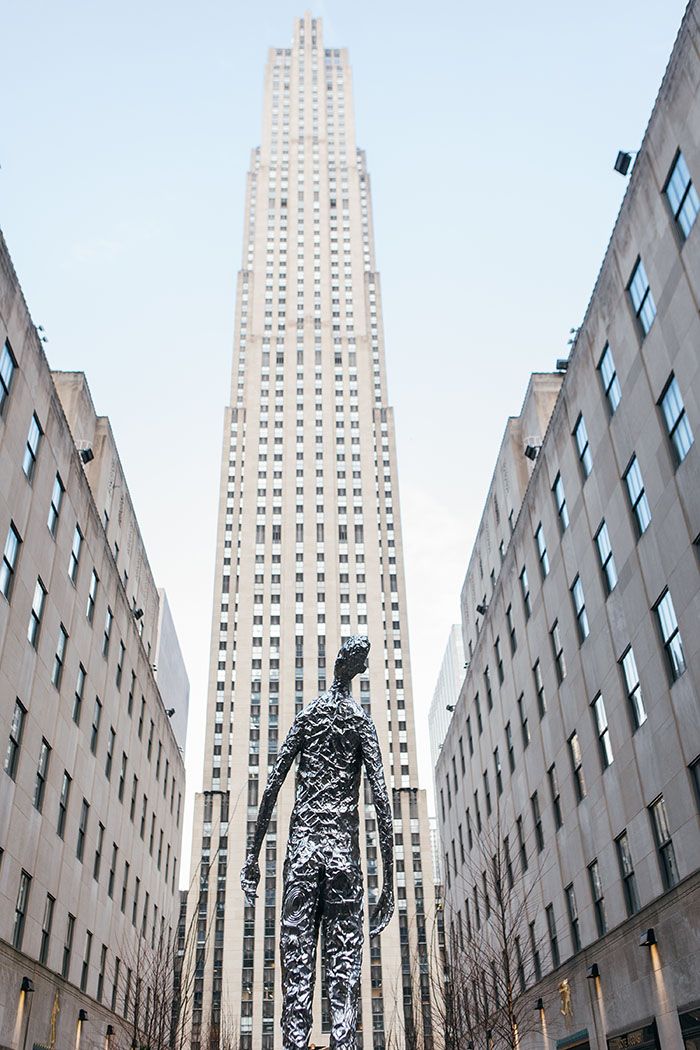
Photo courtesy Tishman Speyer
Tom Friedman’s stainless steel sculptures are instantly recognizable, like a modern-day, oversized Giacommeti sculpture. You may have previously seen a series of his sculptures along the Park Avenue malls between 2015 and 2016. Now, at the entrnace to Rockefeller Center’s Channel Gardens, you’ll find his work, Looking Up.
Described as a “quasi-human figure gazing up to the heavens,” Looking Up was created from crushed aluminum foil pans through lost wax casting which keeps the imprint of the original materials on the steel. Looking Up will be on view until March 19, 2021. Also on view at Rockefeller Center’s main plaza and in the underground concourse is Hiba Schahbaz’ site-specific exhibition, “In My Heart,” which features prints of a mythological garden.
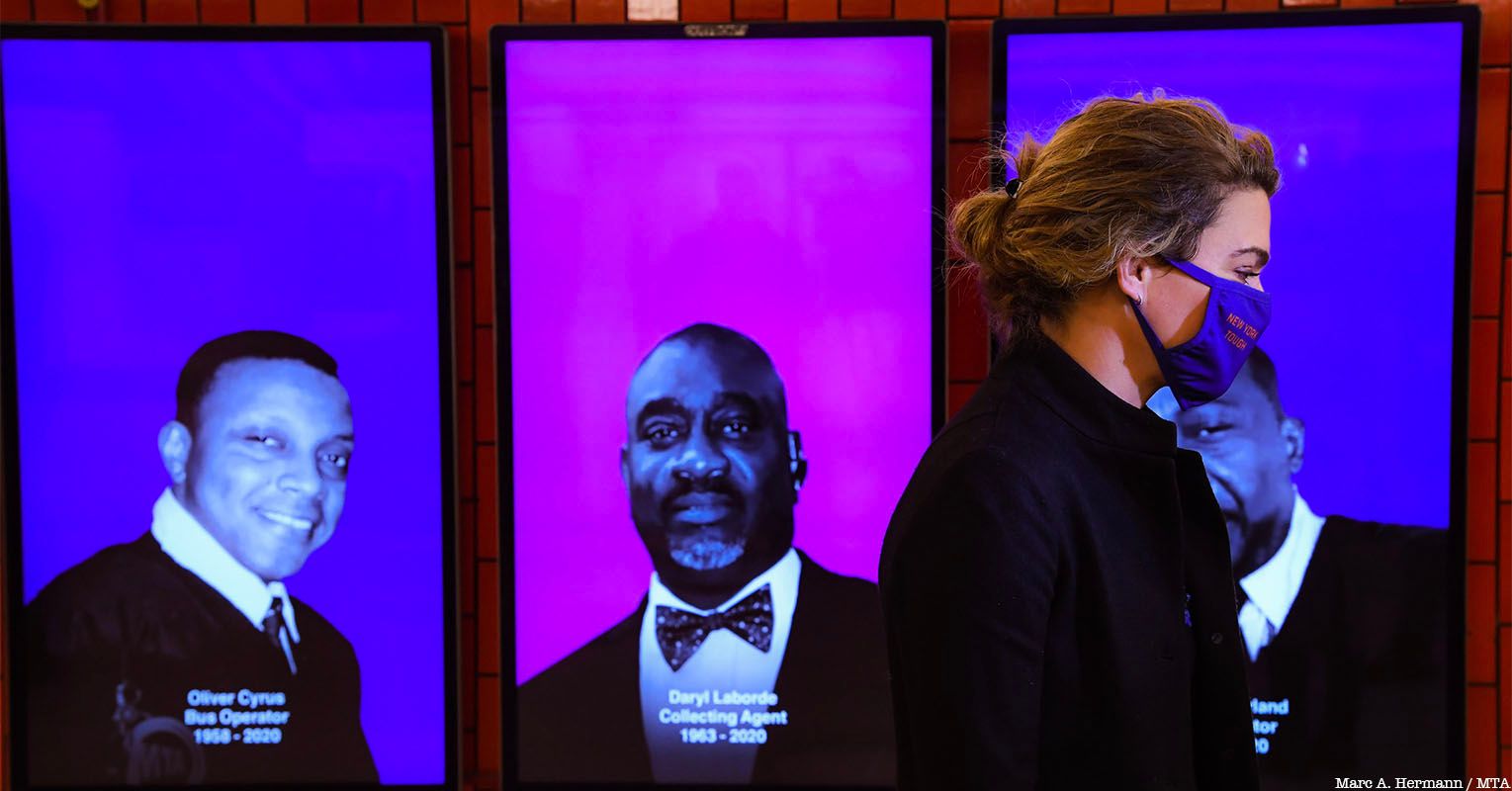
The MTA just unveiled a moving digital memorial in honor of the 136 employees who have died from COVID-19 since the beginning of the coronavirus pandemic. Located in 107 subway stations across all subway lines, the art installation features an eight-minute video showing digital portraits of the fallen workers shared by their families on 138 three-panel digital screens.
The installation is titled TRAVELS FAR, after a poem by former U.S. Poet Laureate Tracy K. Smith. There is also an online memorial which additionally features original music by composer Christopher Thompson commissioned by MTA Arts & Design. TRAVELS FAR puts faces to the sobering statistic, a reminder to New Yorkers of the people they may have encountered in their daily commutes. The video will play twice consecutively three times per day, at 10:30 AM., 2:30 PM. and 8:30 PM until February 7th and is also available to view online.
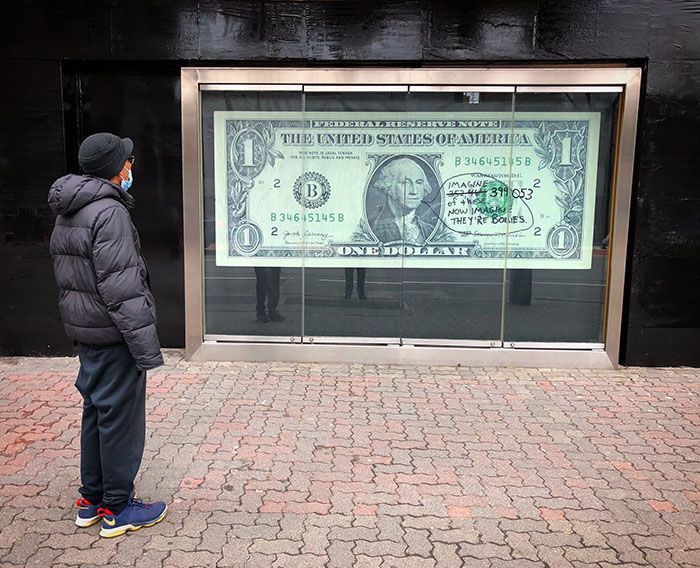
Photo courtesy W42ST
Playwrights Horizon, the not-for-profit Off Broadway Theater has been closed since March 2020, but they’ve installed rotating art exhibitions on the front facade of its building on 42nd Street. The goal is to amplify “the shared aims of visual artists and theater-makers: pursuing social transformation, exposing contradictions of American life, and disrupting routine patterns. Our aim is to breathe new life into an established institution as we imagine our course forward.” Recently installed is an oversized $1 bill entitled “With Great Power Comes No Accountability,” designed by street artist Jilly Ballistic. On top of the dollar bill is written “Imagine 399,053 of these. Now imagine they are bodies.”
In fact, the number was updated from when it was first made, which had 352,464 deaths from COVID-19 in America. Both numbers are already outdated, as the current death count is around 443,000 in the United States. As the artist explains, “It’s difficult to conceptualize such large numbers, especially when those numbers are linked to something so tragic as these deaths. There’s a danger, though, if we don’t fully grasp the atrocity: we allow those in power to get away with murder. What better way for a politician to understand our pain than using money as a metaphor?”
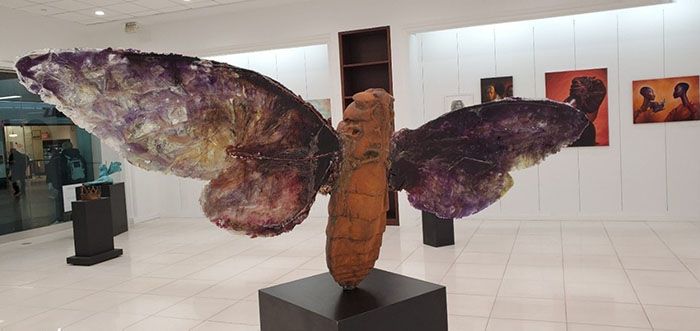
Photo courtesy Port Authority of New York & New Jersey
We love art exhibitions in unlikely places, and there may be no place more unlikely than the Port Authority Bus Terminal. The latest installation is inside the Six Summit Gallery, on the first floor of the bus terminal’s South Wing.
The exhibition “Journey to the Sky” showcases fifteen local and regional artists, eight from New York City, and others from New Jersey and Connecticut (with a handful from outside the area including California and abroad).
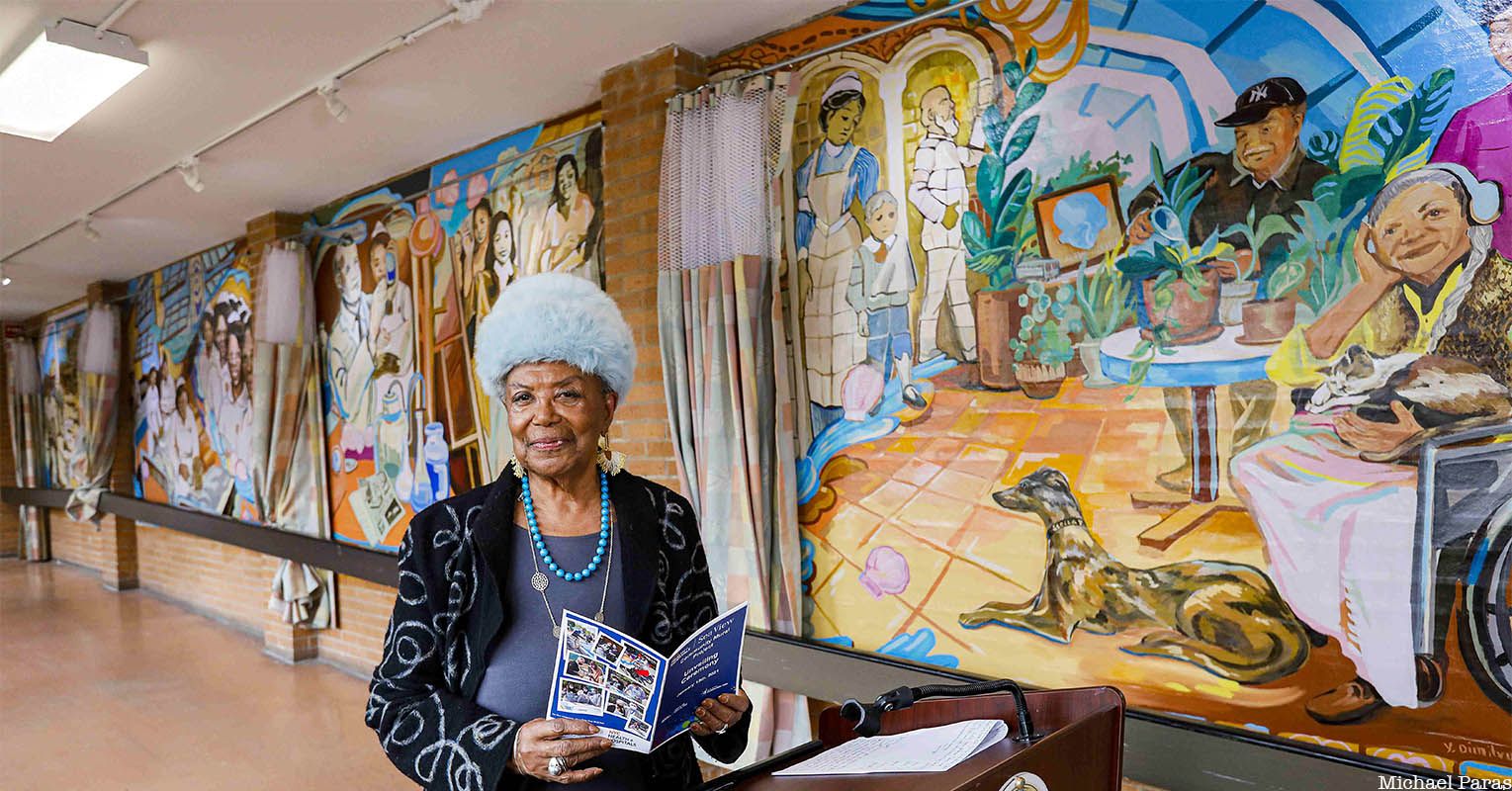
Miss Virginia Allen, the last living Black Angel nurse at the unveiling ceremony in January
Just in time for Black History Month, a new mural has just been unveiled at Staten Island’s Sea View Hospital. “The Spirit of Sea View” by Yana Dimitrova, depicts the hospital’s deep history dedicated to serving the most vulnerable populations of New York, including the role of the Black Angels. The project was completed under New York City Health + Hospitals Community Murals Project in partnership with the Laurie M. Tisch Illumination Fund and is located in the E. Robitzek Building at Sea View.
It consists of four panels, each highlighting significant individuals and events of Sea View’s past. In the mural, you’ll see a reference to the Delft terra cotta panels that were salvaged from the abandoned tuberculosis buildings in the hospital. One of the panels focuses on the Black Angels of Seaview Hospital who were critical in providing care for patients during the tuberculosis pandemic (the cure for tuberculosis was discovered at Sea View). Called Black Angels by their parents, around 300 of African American nurses came to Seaview from across the country between 1928 to 1960 to help patients fight tuberculosis. Although many white nurses left Seaview during the height of the pandemic, Black nurses fearlessly and heroically served patients at the risk of their own lives.
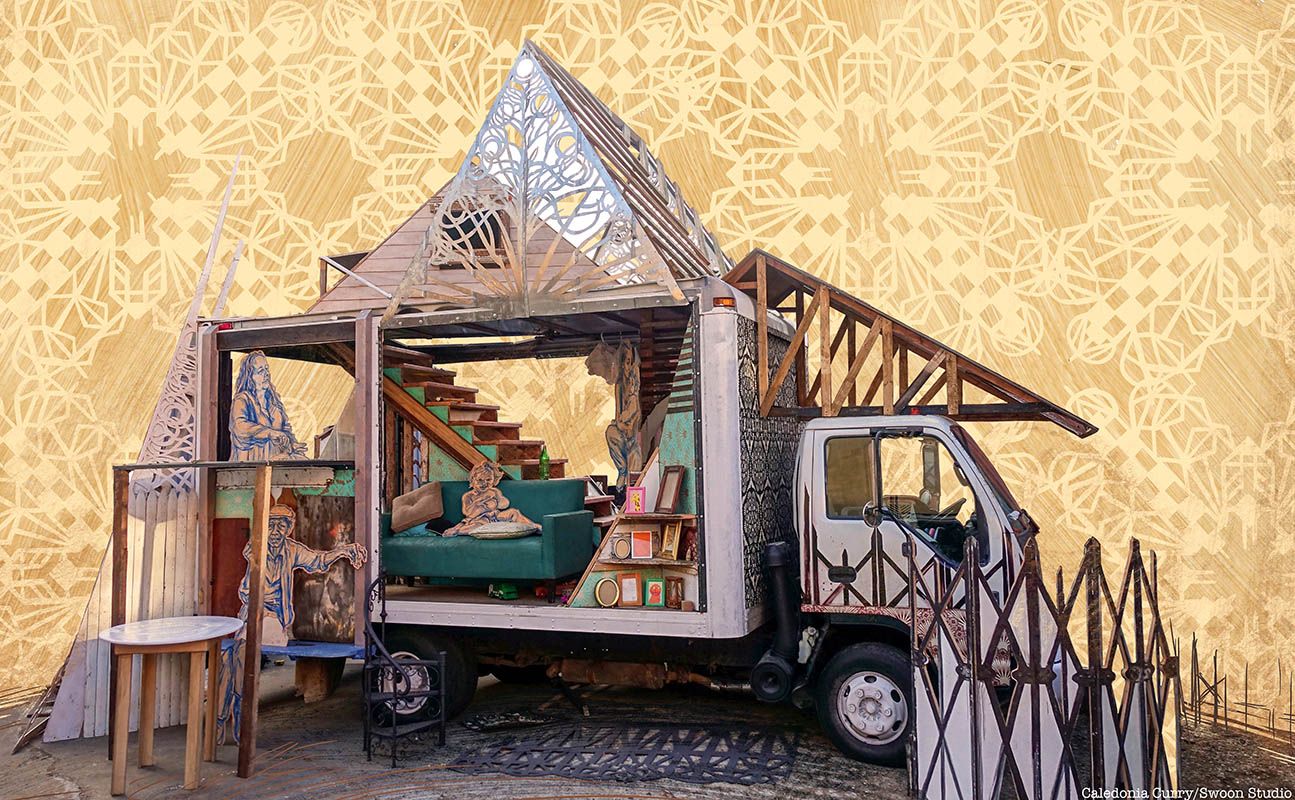
Taking place on four consecutive weekends which began January 30th at Brooklyn Bridge Park Pier 1 ,The House Our Families Built is a mobile public art installation by Brooklyn-based artist Caledonia Curry (Swoon) with Jeff Stark. The fantastical diorama-styled sculpture is constructed atop a 14-foot box truck. With its elaborate, hand-built aesthetic, one is reminded of the caravan in the film The Imaginarium of Dr. Parnassus, though instead of stealing souls, the performers recite intergenerational stories and experiences from user generated narratives contained in the PBS American Portrait database.
It is part of a national series commissioned by PBS, from its American Portrait initiative on what it means to be American today, a major storytelling project in celebration of the network’s 50th anniversary. You can find the truck on upcoming weekends at Prospect Park at Flatbush and Empire (Feb 6-7), Flushing Meadows-Corona Park (Feb 13-14), and Union Square at NOrth Plaza/17th Street on Feb 21st.
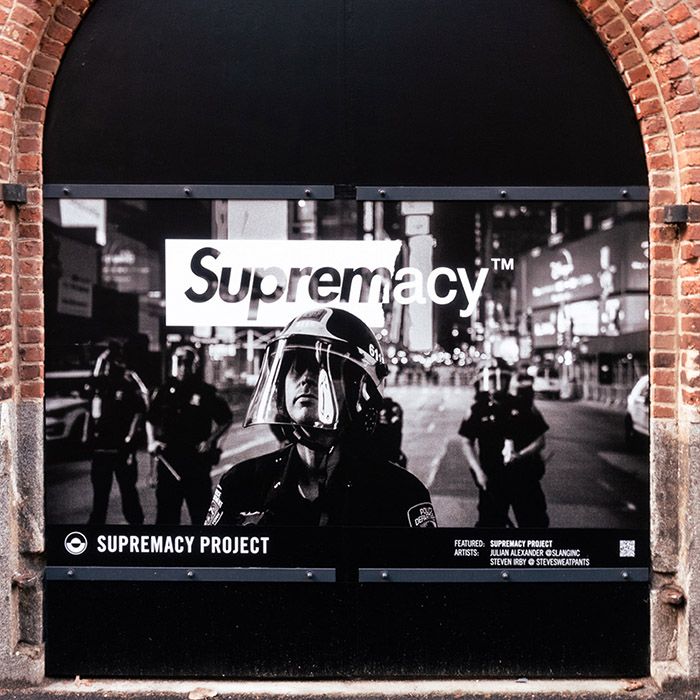
Photo courtesy Julian Alexander
On the facades of St. Ann’s Warehouse in Dumbo, Brooklyn, you can find Julian Alexander & Khadijat Oseni’s Supremacy Project, a public art project that addresses “the systemic oppression and violence BIPOC communities are fighting to end through art.” The project began after the killing of George Floyd and uses photography, poetry, design and branding to “evoke the ubiquitous nature of injustice in American society.” The core images are both familiar culturally and historically — Mount Rushmore, for example — or rooted in current events — police officers in riot gear in Times Square. They are juxtaposed with branding that looks like that of the company Supreme, or with other imagery, to provoke conversation.
The project is a combination of two exhibitions: Michael T. Boyd’s Lost Ones. Culture Found, which reexamines the legacy of widely known victims of police brutality and hate crimes, on the building’s Water Street facade; and Julian Alexander and photographer Steven “Sweatpants” Irby’s Supremacy: Who Protects Me From You?, which illuminates the systemic inequities at the core of our government, on the Dock Street exterior of St. Ann’s Warehouse. The forerunner to this installation, 21-foot murals entitled Supremacy: Who Protects Me From You?, was first installed in the Brooklyn Navy Yard last summer. The panels were defaced repeatedly, “reinforcing the work’s message.” The Supremacy Project will be on view until April 25th, 2021. St. Ann’s Warehouse was also hosting impromptu rooftop concerts during the pandemic, which were intended to be appreciated by people from afar on the ground.
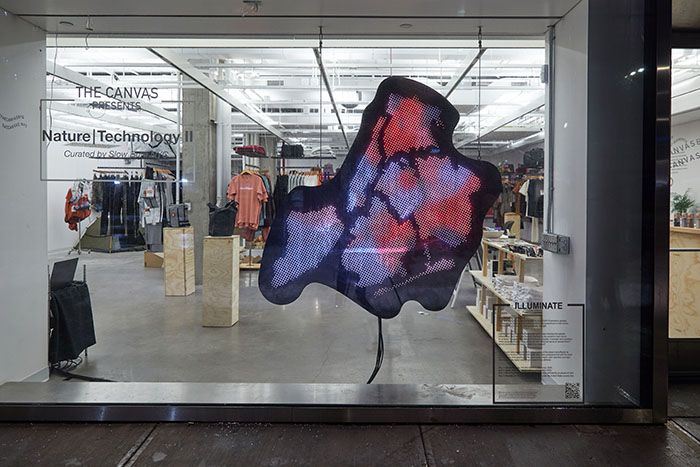
Photo by Alex Contell
The Illuminate Project Collective, a collective of New York City-based planners and architects, has just installed a digital light installation in the windows of 250 Bowery (The Canvas on Bowery) that explores the pandemic impact on New York City. The work of art depicts the five boroughs through data visualizations that dramatically show communities that were hardest hit by COVID-19. According to the artists, “the installation we developed operates as a vessel for public data about New York City and currently explores discrepancies in the way the pandemic affected various communities.
Specifically, the installation “uses light intensity and color saturation to form a sequence of data maps, first illustrating the neighborhoods most affected by COVID-19 in terms of infection and death rates, then juxtaposing them with the racial and economic demographics of the same areas. The sequential overlay suggests and exposes structural inequities. It aims to prompt viewers to question, what causes these disparities across our city? What can we do to counter them? Which communities are most in need of our support?” As COIVD-19 vaccination data becomes available, mirroring the inequities seen since the beginning of the pandemic, these visualizations that make data accessible and understandable to the public are more important than ever.
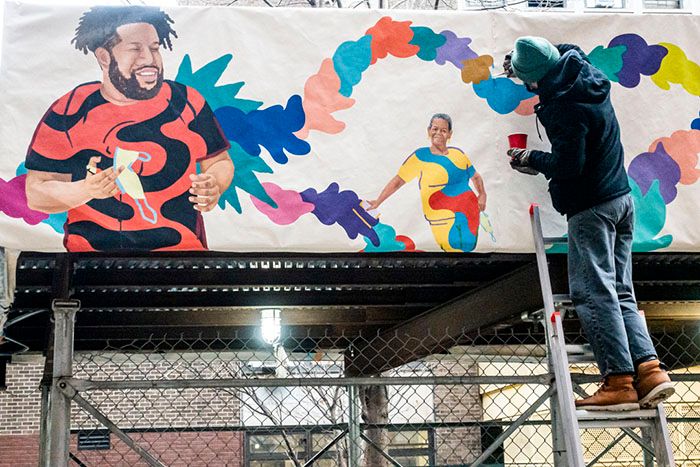
Photo courtesy ArtBridge
Interwining Colors, a large-scale, hand-painted mural by artists Hisham Akira Bharoocha and Maria Lupianez is now on display through June 2021 at NYCHA‘s Fulton and Elliott-Chelsea Houses in Manhattan. The mural features portraits of members of the local community, who according to the ArtBridge, the organization behind the work, are “each dancing joyously, alone yet still connected.” The project was also made possible by Facebook Open Arts and NYC Cultural Affairs.
Intertwining Colors is 355 feet long, painted across 55 panels of outdoor construction scaffolding. You can find it along 17th Street between 9th and 10th avenues and on 26th Street between 9th and 10th avenues.
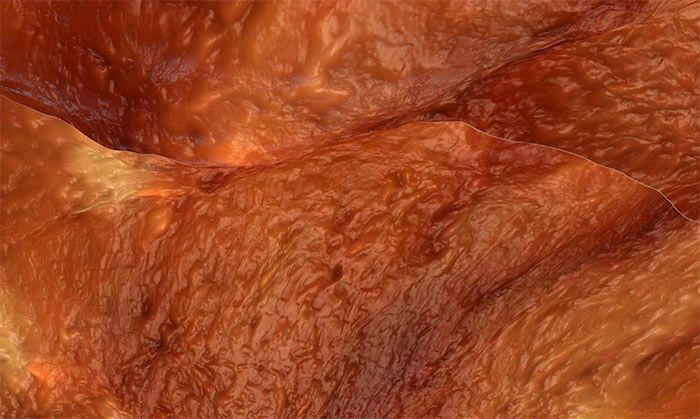
Sondra Perry’s Flesh Wall, courtesy Times Square Arts
Every month a new video installation takes over the screens of Times Square at midnight for Midnight Moment, the world’s longest running digital art exhibition. This month from 11:57 PM to midnight, the screens will be taken over by artist Sondra Perry, in a work entitled Flesh Wall. It’s an “animation of a super-modulated, highly processed image of the artist’s skin — so magnified that it takes on a nearly unrecognizable form.” Says Perry, “the flesh loses all kind of realistic render, but you gain some kind of understanding of what creature-ness is or what identity means outside the label of human.”
According to Times Square Arts, Perry “uses video, performance, and digital manipulations to explore notions of identity, representation, and Blackness, both from an intimately personal perspective and a historical lens.” Flesh Wall expands this work to “monumental proportions across the billboards of Times Square.”
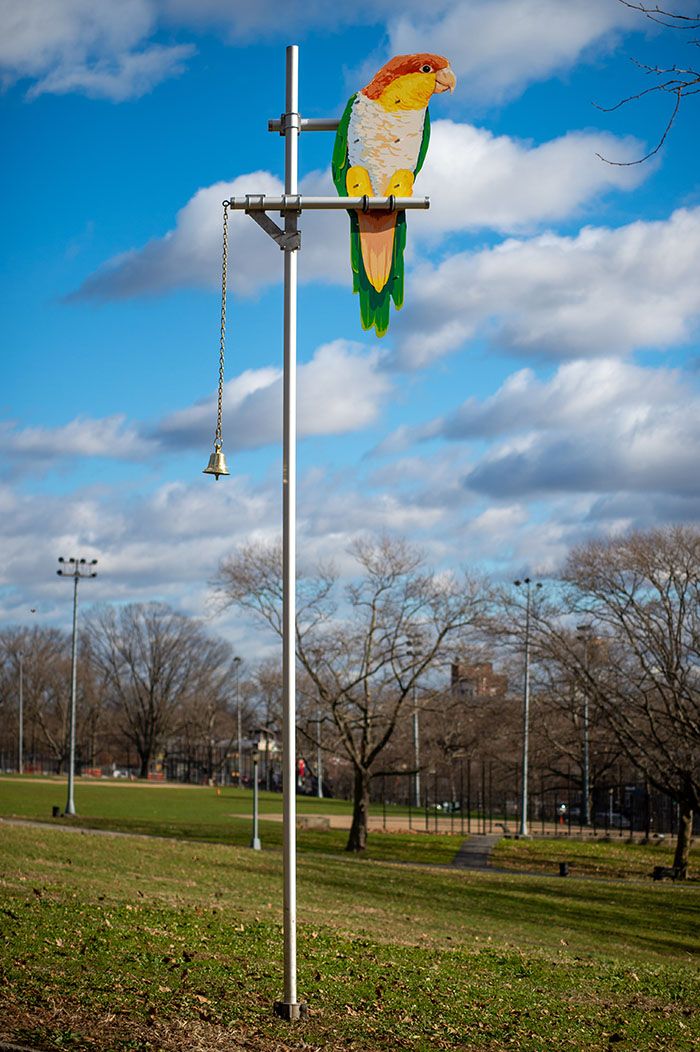
Photo courtesy of Daniele Frazier
In Highland Park, on the border of Brooklyn and Queens, this work of art by Daniele Frazier sits twenty feet high atop a metal post. The “Big Bird” a white-bellied caique parrot, is six-feet tall, made out of aluminum and hand painted in sign enamel.
“Big Bird” is an installation is by NYC Parks which states that the bird is perched “as if it were surveying the activities of park-goers below. Hanging from the perch is a bronze bell, recalling the types of ‘enrichment’ toys that are provided for caged birds. In keeping with themes of Frazier’s past works that depend on interaction with the weather, the bell rings in high winds and can be heard even where the piece cannot be seen.” Another recent art installation in Highland Park was a 3,000 tulip display. Keep reading to see what installations from past months are still on display!
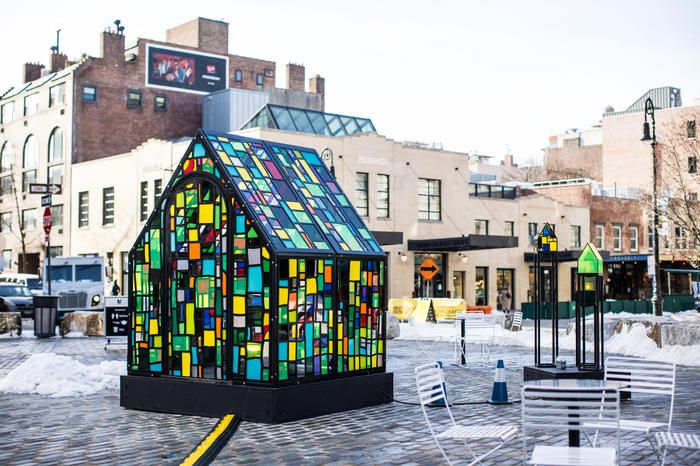
Jim Fryer / BrakeThrough Media
Bombora House is the latest New York City installation by Brooklyn-based sculptor Tom Fruin. The colorful piece at Gansevoort Plaza takes inspiration from Fruin’s artist friends. Melinda Brown, a fellow artist, says that in her native land of Australia, “Bombora refers to a large wave with its own frequency. Surfers will wait for the bombora to roll in.” Brown adopted that name for the building she lived in on the corner of 13th Street and Ninth Avenue where artists would gather and create together.
Fruin’s own Bombora House represents the wave of cultural and architectural evolution rolling through the Meatpacking District. The tiny house-like structures are meant to also convey feelings of hope, joy, and stability. You can interact with the sculpture by sending a text message to 347-328-2636. You will get a response with more information about the sculpture or things to do in the Meatpacking District, and the sculpture will light up! Bombora House will be on view throughout the winter of 2021. Check out Tom Fruin in our latest podcast episode of Secrets of New York!
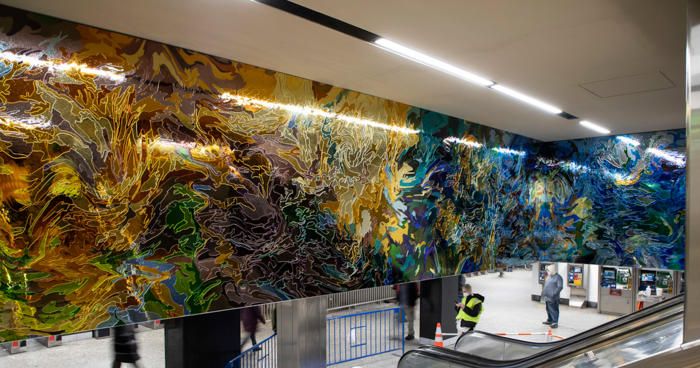
I dreamed a world and called it Love(2020) ©Jim Hodges, NYCTransitGrandCentral-42StStation. Commissioned by MTA Arts & Design. Photo by David Regen. Courtesy the artist and Gladstone Gallery, NewYork and Brussels
A new permanent artwork by contemporary artist Jim Hodges has added some color to the staircase and escalator landings that connect the Grand Central-42nd Street subway station to Grand Central Terminal. I dreamed a world and called it Love is a massive mirrored-glass sculpture that builds upon Hodges’ 2016 exhibition of the same name at Gladstone Gallery. The new installation is made up of more than 5,000 individually cut pieces of glass in more than 70 colors.
The multi-colored glass pieces swirl together in a rainbow camouflage pattern of blues, greens, reds, golds, and purples. Measuring 700 square-feet in total, the mesmerizing piece forces your glance upwards as you travel between the subway and train stations. The new piece adds a pop of color and excitement to the daily commute.
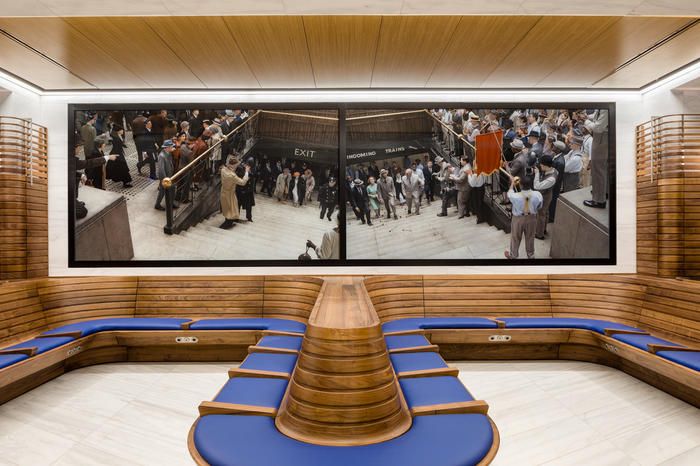
22 April 1924 and 7 August 1934, from Penn Station’s Half Century, 2020 Ceramic ink on glass. One of nine photographic panels from Penn Station’s Half Century Commissioned by Empire State Development in partnership with Public Art Fund for Moynihan Train Hall ©Stan Douglas. Courtesy of the artist, Victoria Miro and David Zwirner.
The opening of the new Moynihan Train Hall brings with it three new site-specific art installations that will be permanent features of the station. The works were created by artists Stan Douglas, artist duo Elmgreen & Dragset, and Kehinde Wiley. Commissioned through a partnership between Empire State Development and Public Art Fund, the pieces can be found in various spots throughout the station.
In the Ticketing Room adjacent to the Train Hall’s sunlight-filled main atrium, visitors will see Stan Douglas’ photo series, Penn Station’s Half Century. The installation consists of nine photographs that “capture the serendipity and poignancy of daily life.” Displayed on 22-foot-long wall panels around the room, Douglas’ photographs feature live actors in period costume set amongst digitally recreated interiors of the demolished Penn Station. The images pay tribute to McKim, Mead & White’s original station, which lasted from 1910 to 1963. The scenes depicted include a gathering of Communist party members in 1934, a soldier kissing his lover goodbye before being deployed during World War II, and other scenes from Penn Station’s history.
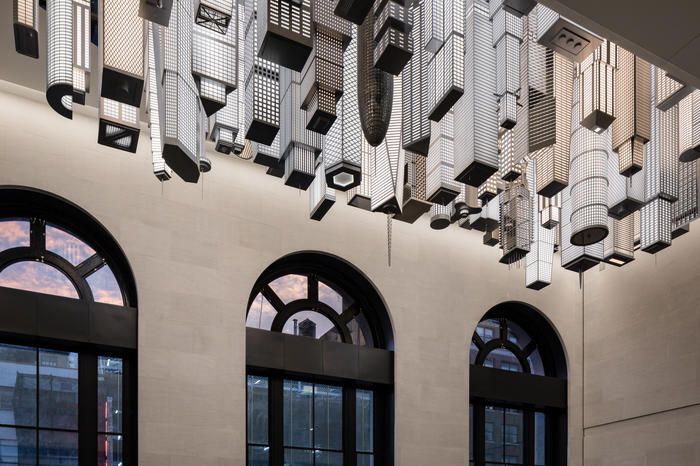
Elmgreen & Dragset, The Hive, 2020, Stainless steel, aluminum, polycarbonate, LED lights, and lacquer. Commissioned by Empire State Development in partnership with Public Art Fund for Moynihan Train Hall Photo: Nicholas Knight, courtesy Empire State Development and Public Art Fund
On the ceiling above the 31st Street entrance to the new Moynihan Train Hall, the artist duo of Elmgreen & Dragset have installed a fantastical inverted cityscape. Tilted The Hive, the cityscape is inspired by iconic buildings of New York City and cities around the world. The illuminated structures hanging from the ceiling like stalactites weigh a whopping 30,000 pounds, yet appear weightless.
72,000 LEDs light up the imagined buildings, which stretch to heights of up to nine-feet tall. The sculptural piece will be one of the first things LIRR and Amtrak riders will see as they enter the new train hall inside the 1912 Farley Post Office building.
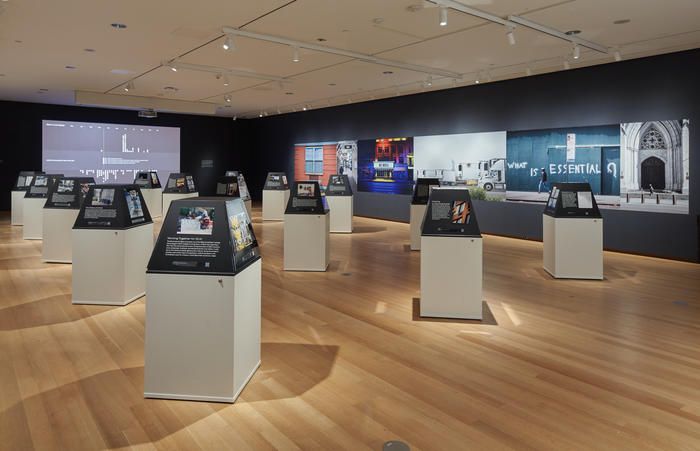
Courtesy of the Museum of New York City
A new crowd-sourced exhibit at the Museum of the City of New York, New York Responds: The First Six Months, takes a look back on 2020 and how New York City has handled all of the challenges brought by the past year. Tens of thousands of photographs, videos, and other works of art were submitted to the museum by New Yorkers across the five boroughs. Submissions were whittled down by a jury of twelve diverse New Yorkers who helped museum curators pick which pieces to include in the exhibit.
The perspectives of more than 100 New Yorkers are represented in the works on display in the exhibition. New York Responds: The First Six Months will be on view through April 11th, 2021. You can buy timed tickets for entry on the museum’s website.
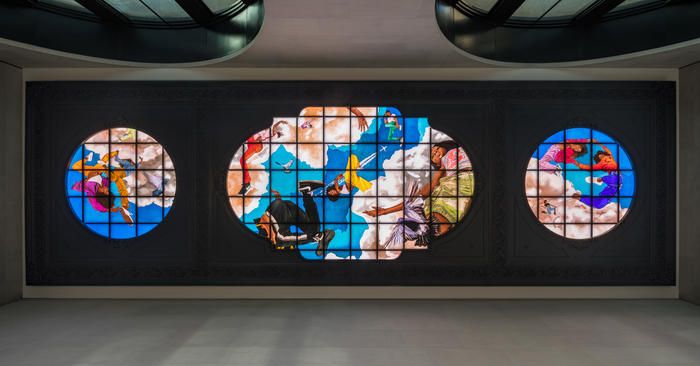
© Kehinde Wiley.Anoriginal work of art commissioned by Empire State Development in partnership with Public Art Fund for Moynihan Train Hall. Photographer: Nicholas Knight. Image courtesy of the Artist, Sean Kelly, New York, Empire State Development and Public Art Fund, NY
As you enter Moynihan Train Hall at the 33rd Street Midblock entrance, look up to see Kehinde Wiley’s new artwork, Go. The site-specific installation is a backlit, hand-painted, stained-glass triptych inspired by Giovanni Battista Tiepolo’s 18th-century ceiling frescoes. The painting reimagines decorative Renaissance and Baroque paintings and gives the style a modern twist.
Wiley’s fresco features young, Black New Yorkers in breakdance poses floating amongst a sky filled with clouds, pigeons, and a jet plane. Rather than wearing tunics and robes like the subjects in classical frescoes, Wiley’s subjects are in sneakers, crop tops, and hoodies. Mixing elements from modern-day New York City with the 18th-century painting style creates a “surrealist dreamscape that advances a narrative of buoyancy, possibility, and survival.”
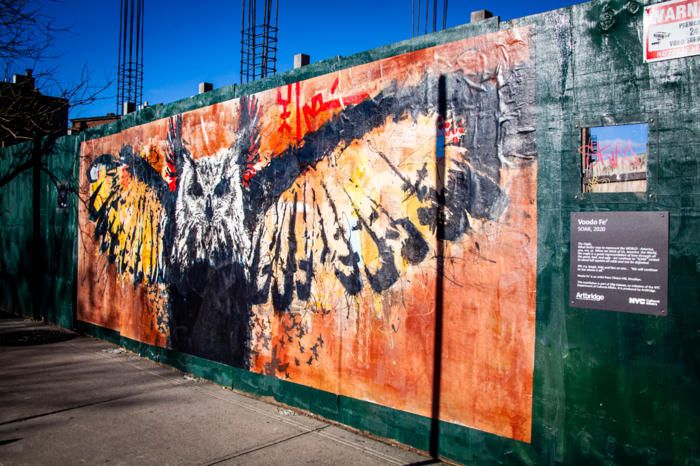
Image Courtesy of ArtBridge
Voodo Fé‘s new Brooklyn mural depicts a vibrantly colored eagle in flight. SOAR, presented by ArtBridge, is a 20foot-wide mural on construction fencing in Clinton Hill, Brooklyn, at the interception of Fulton and Downing Streets. The hand-painted piece is meant to “depict the diversity of the world, inspiring us to rise above all odds.” A sign that accompanies the mural states that the image of the eagle is “a great representation of how through all, the good, bad, and ugly – we continue to ‘SOAR.'”
Voodo Fé, a well-known local figure in the Clinton Hill and Bed Stuy neighborhoods, used bright colors in his mural to lift and inspire his community. He hopes that the mural will spread the healing effect of art which he shares at The Spot, his art space on 572 Myrtle Avenue. SOAR is part of the City Canvas pilot program, an initiative of the NYC Department of Cultural Affairs that adds temporary visual art to sidewalk sheds and construction fences throughout New York City.
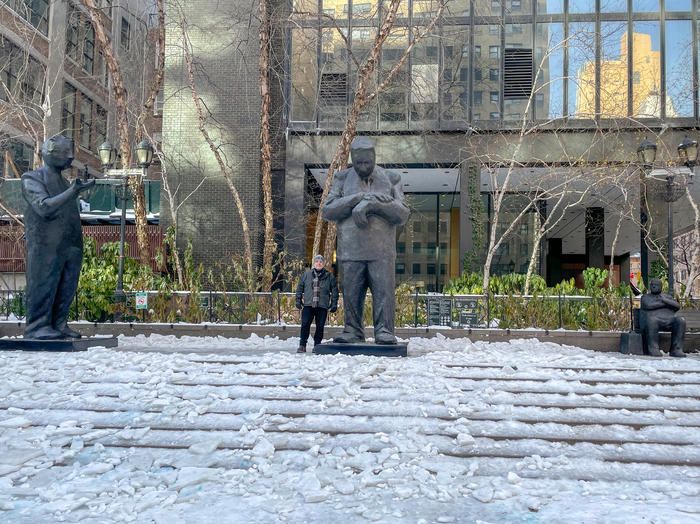 Photo Courtesy of Jim Rennert/Cavalier Galleries
Photo Courtesy of Jim Rennert/Cavalier Galleries
Five monumental sculptures by artist Jim Rennert, all standing over 12.5-feet tall, have been installed in the Theater District and Dag Hammarskjöld Plaza. The pieces belong to two collections by Rennert, Walking the Tightrope and WTF. Rennert’s work explores the physical and psychological challenges of the competitive corporate world.
“As an entrepreneur, whether dealing with employer’s products, home life or working our way up the corporate ladder, the visual juxtaposed figure on a tightrope is something that resonates with us all,” said Jim Rennert in a press statement. You can find see Walking the Tightrope and WTF at the entrance to 1700 Broadway and will be on display through 2022. Rennert’s three other sculptures, Timing, Inner Dialogue and Commute are located at Dag Hammarskjöld Plaza on East 47th Street and can be viewed through August 2021.
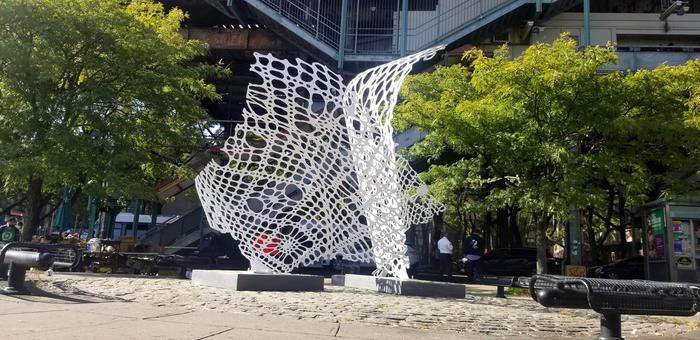
Samantha Holmes, Mundillo (Little World), 2020, Steel, 14 x 8 x 10 feet, Commissioned by the Bronx River Arts Center and the NYC Department of Transportation, as part of its Arts Community Commissions series. Courtesy of JHB Gallery
At West Farms Square Plaza in the Bronx, artist Samantha Holmes has crafted a giant steel sculpture that looks dainty, but is strong and resilient. The painted steel sculpture, tilted Mundillo (Little World), is a “monument to women’s work and the cultural dynamism of the Bronx.” Holmes takes inspiration from the patterns of traditional Puerto Rican lacework to represent softness, while the steel show strength.
Openings in the sculpture’s lace-like surface allow it to seemingly weave into the fabric of the surrounding neighborhood, as those holes are filled with the colors and sights of the neighborhood. Holmes’ sculpture was commissioned by the Bronx River Arts Center and the NYC Department of Transportation, as part of its Arts Community Commissions series. The piece will be on view adjacent to the East Tremont Avenue subway station through September 2021.
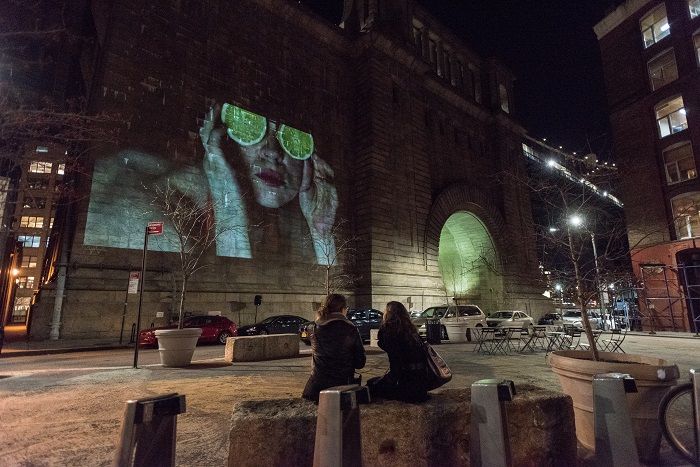
Photo by Julienne Schaer
Socially distant winter video art installation Light Year returns to Dumbo this month. Some of the largest outdoor video art installations in New York City will be projected on the Manhattan Bridge each first Thursday of the month from dusk to 10pm at dimensions of 65 by 40 feet. The full installations are approximately 30 minutes in length.
You can also stream the installations on Facebook Live from 2pm to 10pm on the scheduled projection day, and at dusk, the works can also be viewed online in real time from the projection site also on Facebook.
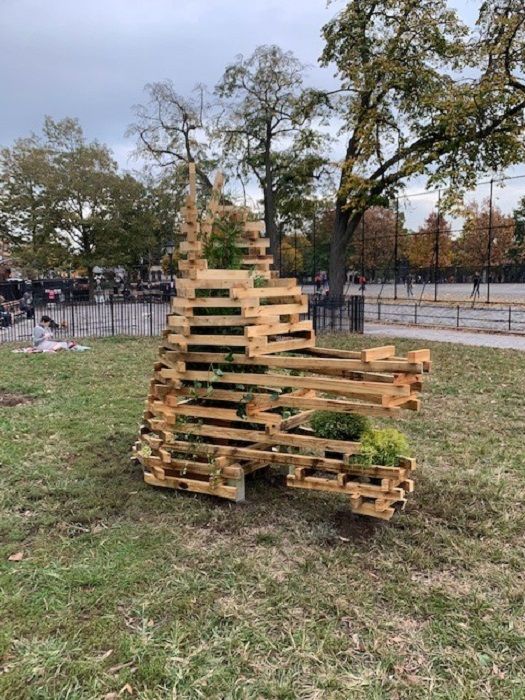
Photo Courtesy of the artist
Artist Alex “Rocko” Rupert’s wolf head wooden structure TimberWolf at Maria Hernandez Park in Brooklyn takes utilitarian materials like reclaimed lumber to beautify this corner of the park and serves as a metaphor for how everyday materials can be repurposed. It plays into the importance of resourcefulness, breathing use back into what is considered to be “used-up.” The artwork takes the form of a dog’s head, a nod to the popular nearby dog park.
At the end of the public art installation period next October, TimberWolf will be donated to another public space to be enjoyed. The possibility to be reused or repurposed with additional functionalities gives this living installation another life. The installation will be on site through October 25, 2021.
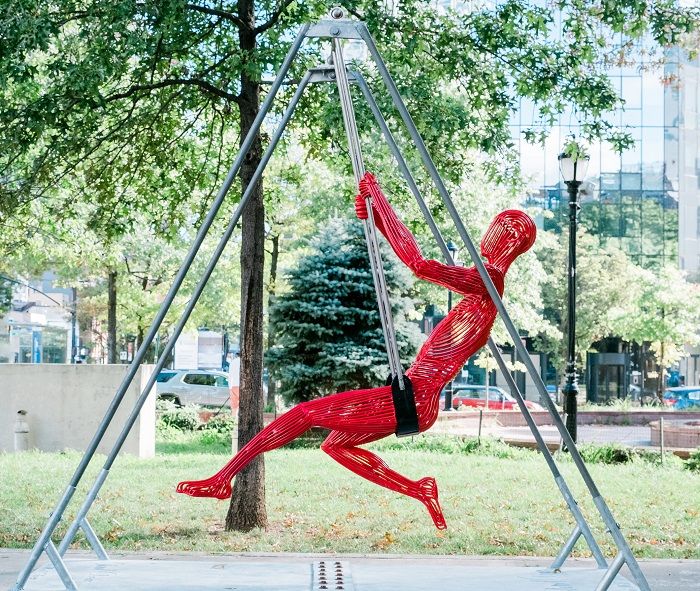
Photo by Reiko Yanagi, courtesy of the artist
Long Island City-based sculptor, Jack Howard-Potter, makes large, often kinetic, figurative steel sculptures that can be seen in city governments, sculpture parks, and public art shows around the country. The outdoor public arena is the perfect setting for the academic roots to be easily recognizable and accessible, bridging the gap between the fine art institution and the public. It all comes together in an effort to brighten the landscape and shift one’s gaze to break the daily routine with something beautiful.
Torso II, Swinging II, Messenger of the Gods will be on-site at Court Square Park in Queens through September 12, 2021.
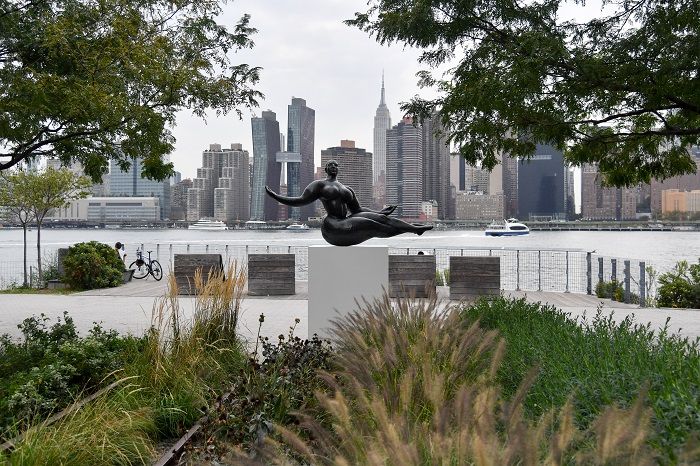
Photo by Daniel Avila, courtesy of NYC Parks
Located in Hunter’s Point South through September 2021, this work is one of French sculptor Gaston Lachaise’s best-known, monumental works dating from the late 1920s. The buoyant, expansive figure represents a timeless earth goddess, one Lachaise knew and sought to capture throughout his career. This vision was inspired by his wife, who was his muse and model, Isabel, that “majestic woman” who walked by him once by the Bank of the Seine. This work is a tribute to the power of all women, dedicated to ‘Woman,’ as the artist referred to his wife, with a capital W.
Lachaise devoted himself to the human form, producing a succession of powerfully conceived nude figures in stone and bronze that reinvigorated the sculptural traditions of Auguste Rodin and Aristide Maillol.
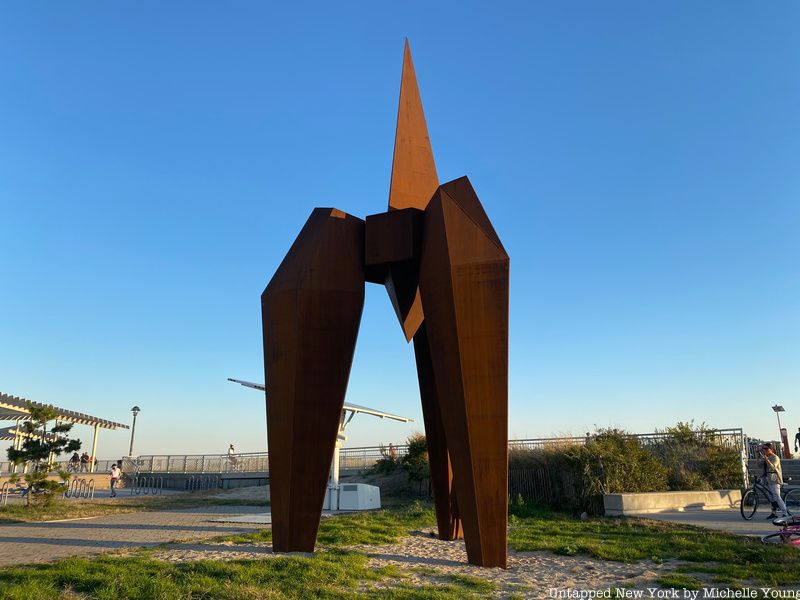
On August 12, a new, 35-foot-tall steel sculpture named Mother Earth was unveiled at Rockaway Beach in Queens. The installation is the brainchild of artist Kris Perry. It is a part of NYC Parks’ Art in the Parks, a program that brings both experimental and traditional pieces of artwork to public locations throughout the five boroughs.
The towering statue is made of Corten steel, a material that is meant to evolve and change with the seasons and the site. Mother Earth will be located at the Beach 98th Street entrance to Rockaway beach, two blocks away from the A-Train until August 11, 2021. Rockaway Beach is also serviced by the NYC Ferry.
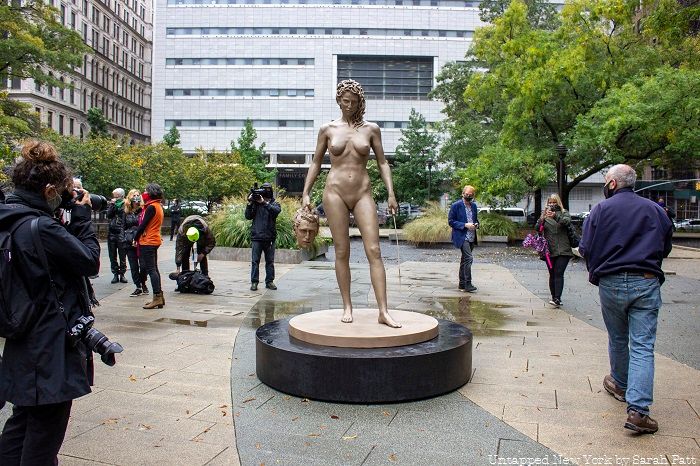
A seven-foot-tall bronze sculpture of Medusa will be on display until April 18, 2021 across from the New York County Criminal Court in Lower Manhattan. A collaboration between Medusa With The Head Project (MWTH) and New York City Parks, Medusa With The Head of Perseus is meant to question Medusa’s portrayal and narrative in Greek mythology and reimagine an inverted narrative.
Garbati made the original Medusa sculpture in 2008. He posted photos of it on social media in 2018, at the height of Me Too movement and the year the Argentine Senate rejected a bill that would fully decriminalize abortion during the first 14 weeks of pregnancy. The photos went viral, and the sculpture became a symbol of resistance for women. Garbati seeks to change the traditional narrative of Medusa by portraying her in a somber moment of self-defense, holding the head of her slayer. According to the organizers of the sculpture, Medusa With The Head of Perseus has been deliberately sited across the street from the courthouse where “high profile abuse cases, including the recent Harvey Weinstein trial.”
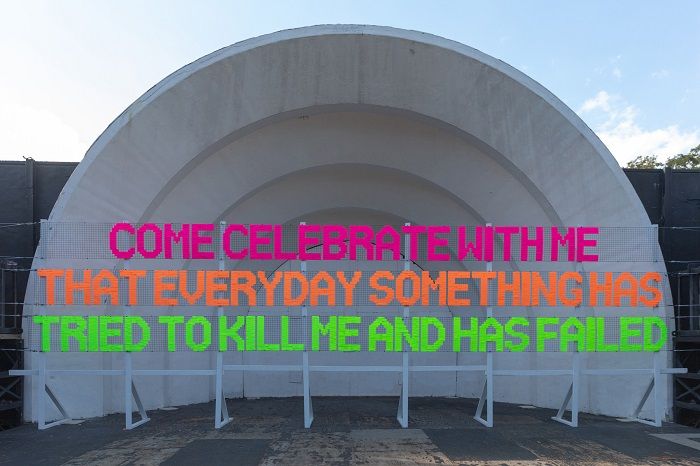
Photo by David Andrako
Prospect Park Bandshell has turned into a venue for artists lately, with the unveiling of a public art project commissioned by Brooklyn artist collective Brooklyn Hi-Art! Machine. Helmed by BRIC and Prospect Park Alliance in their partnership with NYC Parks, the art project utilizes the words of the poet Lucille Clifton to offer “a message of resilience and perseverance.” “This public artwork provides a message of strength and joy, celebrating and uniting our community during these difficult times,” said Kristina Newman-Scott, BRIC’s President, in a press statement. “We are delighted to continue our important partnership with the Prospect Park Alliance through this meaningful activation of the Bandshell inspired by a local and engaged arts collective.”
Displaying themes of racial equity and a different narrative on unoccupied public spaces in the background, Brooklyn Hi-Art! Machine’s project will be on view from October 2020 through May 2021.
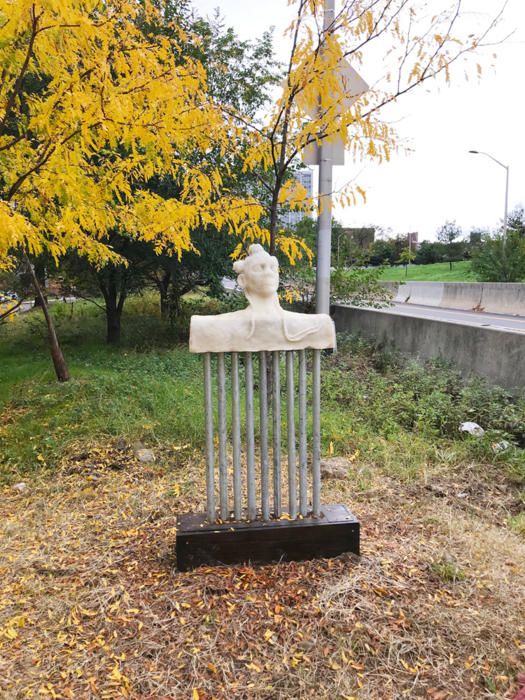 Photograph Courtesy of Elmhurst Sculpture Garden
Photograph Courtesy of Elmhurst Sculpture Garden
Artist Yvonne Shortt’s newest sculpture African American Marbleization: AfroPick: Bantu Knots and the Underground Railroad is the latest addition to the African American Marbleization series, a collection of outdoor sculptures by the artists that pays tributes to people of color and commemorate their history. Based on ancient wood and stone designs made from 5,500 years ago, the sculpture sits in Elmhurst Sculpture Garden which was created in 2016 by a group of volunteers who cleaned up the area.
The face of the sculpture is fractured in order to signify the anguish African Americans experienced in their lives, and the piece presents the path they took in their request for freedom, extending from the U.S. South to New York and all the way up to Canada.
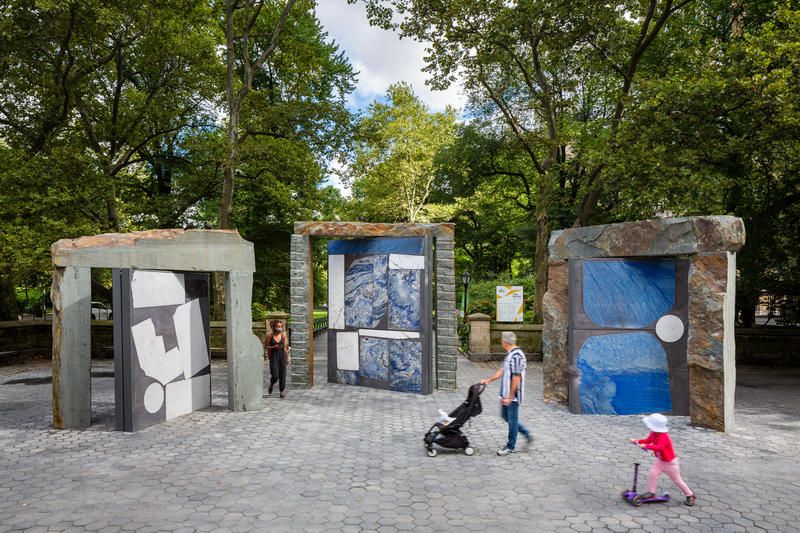
Photo by Nicholas Knight, Courtesy Public Art Fund
Artist Sam Moyer created a massive three-part hybrid sculpture using imported stones and rock indigenous to New York in order to pay homage to Public Art Fund founder Doris C. Freedman at the plaza named for her outside Central Park.
According to Public Art Fund’s website, “these polished stones bear the markings and shapes of their original uses. They also display the unique colors, patterns, and geological history of their sources — quarries in Brazil, China, India, Italy, and beyond. Each stone in Moyer’s mosaic compositions takes on an even more striking hue against the others and the locally-quarried rock, an apt metaphor that encourages us to consider the diverse character of our city and our interconnected lives within it.” The installation will run from September 16, 2020 to September 12, 2021.
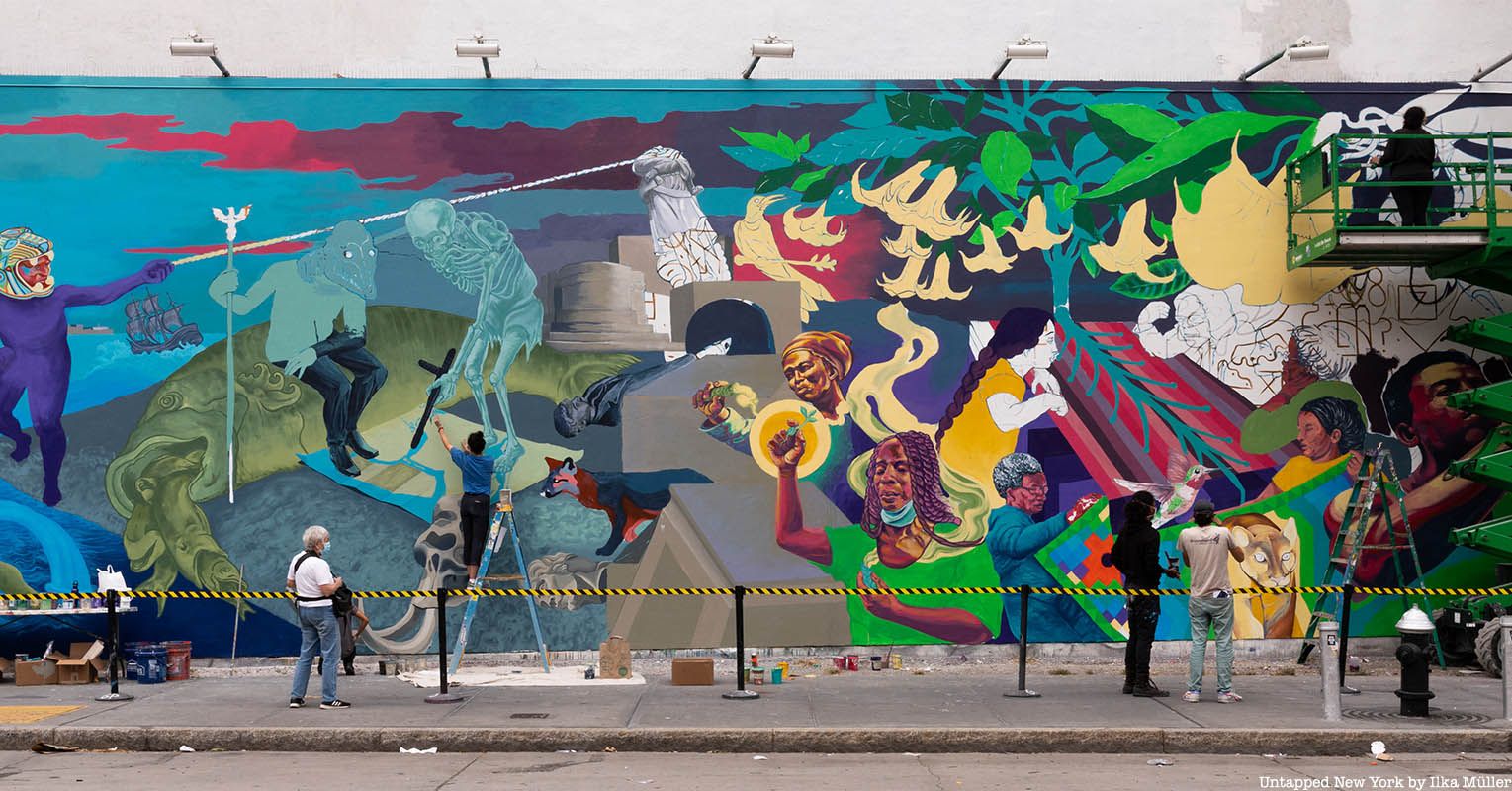
On the Bowery graffiti wall, Groundswell has completed the newest mural to be seen at the street art site in a year. The work was designed by artist Raul Ayala and painted by a team of ten youth artists The last piece, by Japanese artist Tomokazu Matsuyama “Matzu” was completed in September of last year. The mural for 2020 coincides with the 25th anniversary of Groundswell, an organization that uses art for change. The new mural at the Bowery graffiti wall, located on Houston Street between Bowery and Elizabeth streets, incorporates numerous portraits of Black figures and also has a seafaring folklore theme with mythical creatures pulling down statues. On the left side, the skyline of Manhattan appears.
Equidorian-born Raul Ayala has said, “For me, building imagination and sharing knowledge alongside a younger generation of artists is a great manifestation of the fruits of this shift. With this mural, we are also bringing intergenerational participation into a future that honors our past while actively creating a different path of existence.”
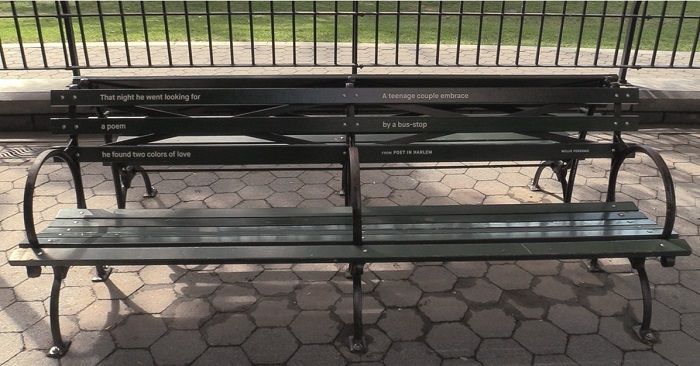
Photo by Daniel Terna
Poets House and Battery Park City Authority (BPCA) launched the Poetry Path, an immersive public art installation which features work from more than 40 poets, at northern length of Battery Park City, from Nelson A. Rockefeller and Teardrop Parks to the North Cove Marina.
The works of the poets, with themes of the relationships between people, nature, and the urban landscape, are reproduced on bench slats, banners, pavers, pathways, and signs. The installation will be up through 2021.
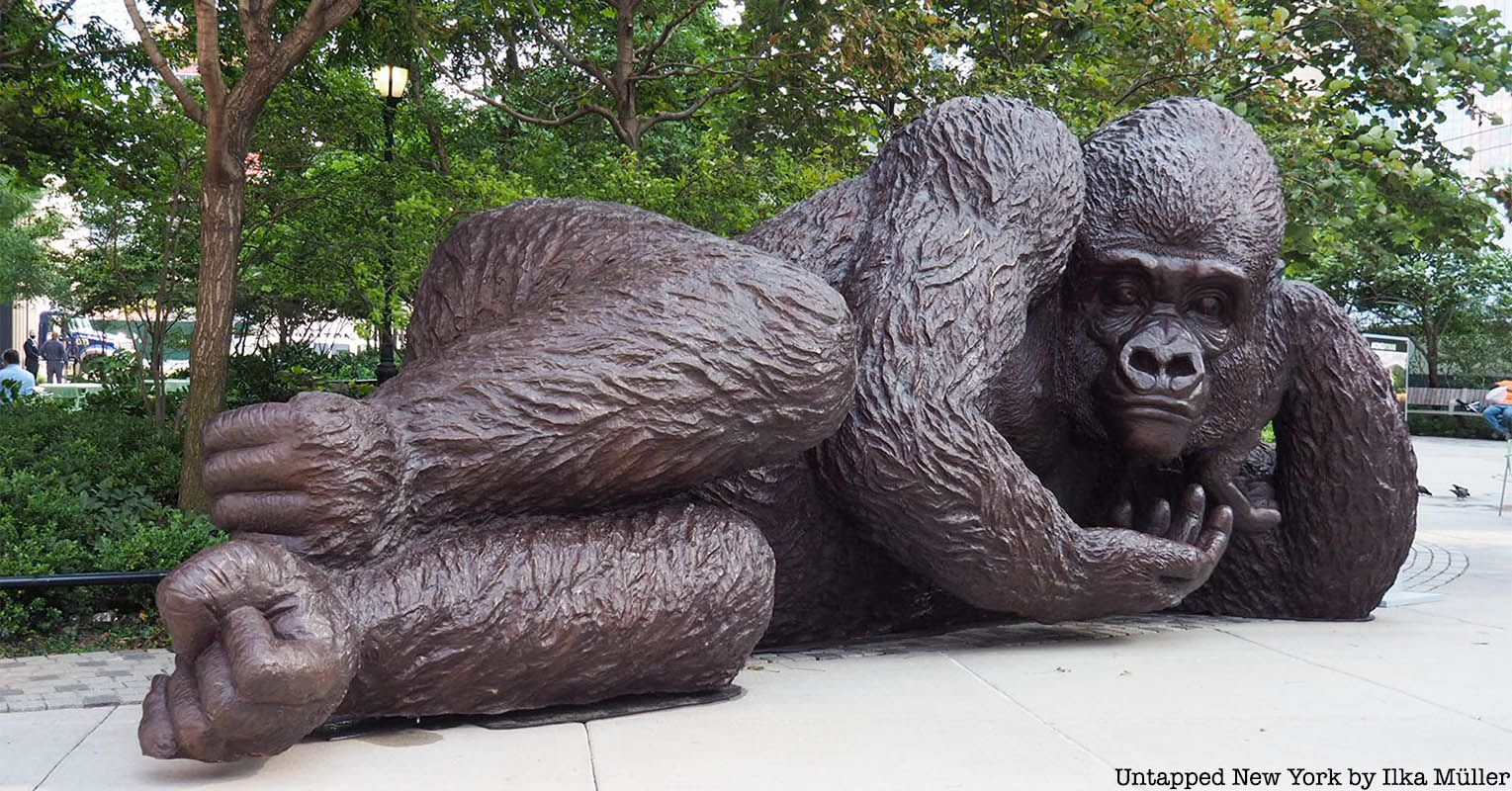
The largest bronze gorilla statue in the world has arrived in New York City. King Nyani is on display at Bella Abzug Park in Hudson Yards. The statue is designed to raise awareness about the endangered mountain gorilla species, of which only around 1000 remain worldwide, and to change the perception of gorillas among New Yorkers. Instead of terrorizing New York City atop the Empire State Building, this gorilla will be giving out free hugs to any willing New Yorkers. In fact, its giant hands are designed to hold 2 to 3 people at a time.
King Nyani is a continuation of a series of works by Gillie and Marc, donated to place around the world, which have highlighted endangered species as part of their initiative Love the Last. Their statues of the last three northern white rhinos were on display in Astor Place in 2018 (now only two of the rhinos remain). King Nyani is based on an actual gorilla, the head of a family of mountain gorillas that Gillie and Marc met on a trip to Uganda. It is almost 23 feet long, 8.5 feet high and weighs 4,766 pounds. See more photos here. King Nyani will be on display through April 2021.

Jeffery Gibson; ‘Because Once You Enter My House It Becomes Our House; 2020; Courtesy the Artist; Socrates Sculpture Park; Sikkema Jenkins & Co., New York; Kavi Gupta, Chicago; Roberts Projects, Los Angeles; Image by Scott Lynch.
A massive new piece, named Because Once You Enter My House, It Becomes Our House, is now on display at Socrates Sculpture Garden in Queens. The vibrantly colored sculpture was created Jeffery Gibson, recipient of the 2019 MacArthur Foundation “Genius Grant.” It is meant to serve as a monument to inclusion and diversity.
Because Once You Enter My House, It Becomes Our House draws inspiration from and pays visual homage to Indigenous North American peoples, pre-Columbian Mississippian architecture, and to modern-day queer camp aesthetics. The multi-tiered structure is a reference to the architecture of the ancient city of Cahokia, the largest city of the North American Indigenous Mississippi people. The installation will be up until March 14, 2021.

Photo: Nicholas Knight, Courtesy of Public Art Fund, NY
Reverberation, a piece by sculptor Davina Semo is on display along the waterfront in Brooklyn Bridge Park. The large-scale installation is made up of interactive bells and is meant to evoke public modes of communication that harken back to New York City’s maritime history. Located adjacent to the Brooklyn Bridge, the piece explores our relationship to industrial material and the built environment. And yes, park visitors can ring the bells! Reverberation will be on view through April 2021.
The installation is supported by the Public Art Fund and was curated by Daniel S. Palmer. The Public Art Fund uses contributions from individuals, corporations, and private foundations to support works of art throughout the five boroughs, including the artwork at LaGuardia Airport’s new Terminal B.
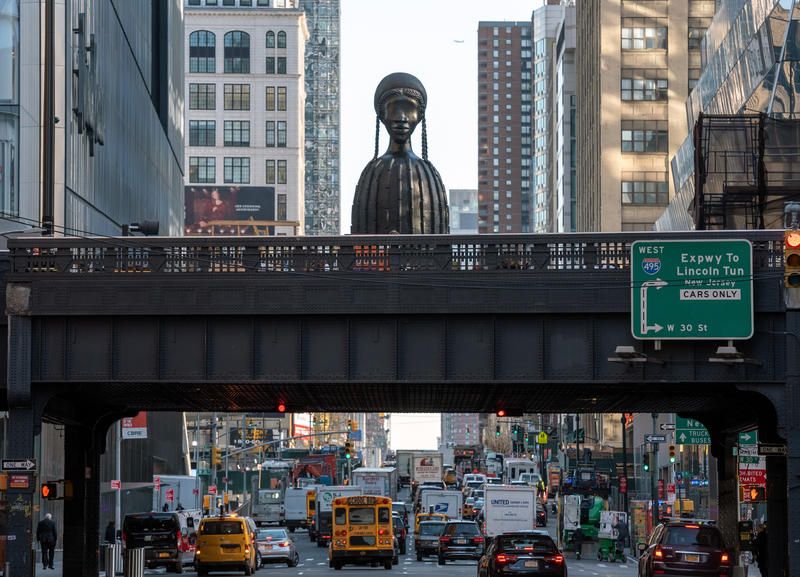
Simone Leigh, Brick House, 2019. A High Line Plinth commission. On view June 2019 – September 2020. Photo by Timothy Schenck. Courtesy the High Line
Simone Leigh’s Brick House has been admired from afar as it loomed over 10th Avenue this past year. This month, visitors can get an up close look at the giant sculpture when the Spur, the newest section of the High Line last year. It was the first sculpture to be displayed in the new space, which will host a series of rotating exhibits.
Brick House, a sixteen-foot-tall bronze bust of a black woman. Her head is adorned with an afro and cornrow braids along her hairline. The figure sits atop the Plinth, a new exhibition space at on the plaza of the Spur. Brick House is the first work in the series Anatomy of Architecture by Simone Leigh. The series of sculptures will intermingle architectural forms from West Africa to the American South with the human body. Brick House has been extended until Spring 2021.
Next, check out our upcoming tours to explore more of New York City!
Subscribe to our newsletter